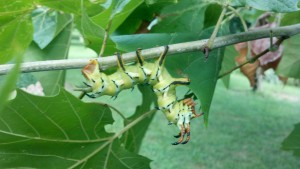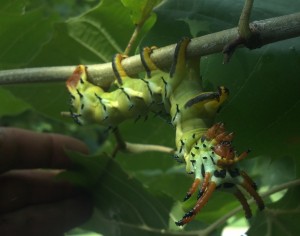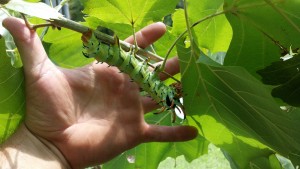Binky Lee Preserve: Giant Creepy Crawlies
By Ariel Senko, communications intern

This impressive hickory horned devil caterpillar was photographed by Jarrod Shull at Binky Lee Preserve. Preserve manager Darin Groff found it hanging from an American sycamore tree. These caterpillars are the larvae of the regal moth (Citheronia regalis), a pretty, scarlet and yellow moth whose wing span can be about five to six inches. They are relatively uncommon in Pennsylvania and even sparser in the New England states, but more common in southern states like Georgia and Florida.
Don’t be fooled by their intimidating looks–regal moth larvae, horns and all, are harmless. Hickory horned devil caterpillars commonly feed on hickory, walnut, sycamore, ash, and sweetgum trees, as well as some others. During their fifth and last larval stage, the caterpillars make their way down the trees to burrow in the ground. They will spend one or two winters as pupae, before emerging in the summer months as adult moths to mate .

The geographic distribution of regal moths suggests that they survive better in warmer regions, but regal moths and their larvae are also less common than they might be because they are preyed upon by flies of the Tachinidae family, whose larvae infest the moths’ pupae and eat them alive. The flies, (Compsilura concinnata), were introduced to the United States in the early 20th century as a biocontrol for the infamous gypsy moth, but turned out to prey on a wider range of native moths and butterflies, and greatly reduced their populations.
Want to see one of these magificant caterpillars or moths near you? If so, refrain from using pesticides in your yard* and get yourself under one of their favorite trees (see list above). You never know, you may get lucky! It’s getting to be that time in the season that the caterpillars have had their fill and are preparing to molt, once more before burrowing in the ground and becoming a pupa.

